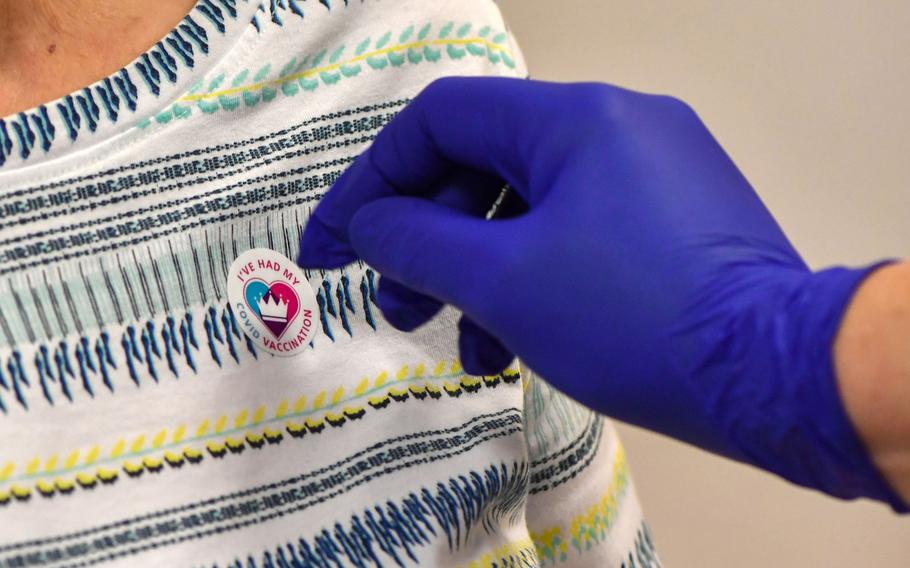
A patient wears a sticker after receiving the COVID-19 vaccine at the Royal Health & Wellbeing Centre in Oldham, U.K. (Anthony Devlin/Bloomberg)
The U.K. government set out plans to relax self-isolation rules that had been designed to stop the spread of COVID-19, amid warnings that infection rates could rocket to 100,000 new cases per day.
Health Secretary Sajid Javid announced that from Aug. 16, “anyone who is a close contact of a positive case will no longer have to self-isolate if they have been fully vaccinated.” The same rule will apply to under-18s, who are not currently being vaccinated, he said.
The news marks the latest step in the government’s plan to get the country back to normal and to encourage the public to learn to live with coronavirus, after most adults have been given vaccines.
Ending the requirement to send whole school year-group “bubbles” home if one child tests positive will also ease the threat of disruption for millions of working parents and their employers.
“Boosting customer and employee confidence must now be the absolute priority for supporting the economic recovery and learning to live with the virus,” said John Foster, director of policy at the country’s biggest business lobby, the Confederation of British Industry. Relaxing self-isolation rules “will lead to less disruption for employers and employees alike.”
Javid also confirmed the government is aiming to remove the isolation requirement for fully vaccinated passengers arriving in the U.K. from medium risk countries.
As the government lifts restrictions that have been in place on and off for the past 15 months, there are fears that infection rates will spiral out of control, and warnings from officials that pandemic measures may need to be reimposed again in the months ahead.
On Tuesday, Javid said new coronavirus cases could rise to 100,000 a day over the summer as the country prepares to relax most of the existing pandemic rules on July 19.
“By the time we get to the 19th, we would expect case numbers by then to be at least double what they are now, so around 50,000 new cases a day,” Javid told BBC Radio’s “Today” program on Tuesday. “As we ease and go into the summer, we expect them to rise significantly and they could go as high as 100,000.”
The stakes are high for U.K. Prime Minister Boris Johnson, who’s overseen the highest death toll from the pandemic in Europe, as well as one of the biggest economic hits. He’s betting that the country’s successful vaccination program means that even as new infections surge, deaths won’t, and that the reopening will help the U.K. economy recover from its worst recession in three centuries.
“We want to be very straightforward about this, about what we can expect in terms of case numbers,” Javid said. “But what matters more than anything is hospitalization and death numbers, and that is where the link has been severely weakened.”
In the U.K., 64% of adults have had two doses of the vaccine.
Neil Ferguson, an epidemiologist from Imperial College London whose modeling was key to the first lockdown, told the BBC that the government was undertaking a “slight gamble” with its reopening strategy. Some 27,334 new daily cases were reported on Monday, according to the latest data. Just 9 deaths were logged.
Ferguson explained that “at the peak of the second wave 50,000 cases would translate into something like 500 deaths, but that’s going to be much lower this time, more like 50 or so.”
One of the risks is that by flagging laxer rules two weeks ahead, many will start abandoning them already, including wearing masks on public transport and keeping a safe distance. With soccer fever running high ahead of Wednesday’s European Championship semi-final pitting England against Denmark, fans are likely to pour into pubs and other crowded spaces to cheer the home team on.
Asked if the government was basically now pursuing a herd immunity strategy, spokesman Max Blain said “Happy to repeat that herd immunity is not a policy goal of the government.”